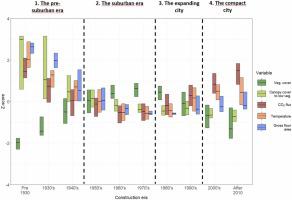当前位置:
X-MOL 学术
›
Urban Forestry Urban Green.
›
论文详情
Our official English website, www.x-mol.net, welcomes your feedback! (Note: you will need to create a separate account there.)
Impact of changing urban typologies on residential vegetation and its climate-effects – A case study from Helsinki, Finland
Urban Forestry & Urban Greening ( IF 6.0 ) Pub Date : 2024-05-07 , DOI: 10.1016/j.ufug.2024.128343 Paula-Kaisa Leppänen , Antti Kinnunen , Ranja Hautamäki , Leena Järvi , Minttu Havu , Seppo Junnila , Outi Tahvonen
Urban Forestry & Urban Greening ( IF 6.0 ) Pub Date : 2024-05-07 , DOI: 10.1016/j.ufug.2024.128343 Paula-Kaisa Leppänen , Antti Kinnunen , Ranja Hautamäki , Leena Järvi , Minttu Havu , Seppo Junnila , Outi Tahvonen

|
Residential green spaces are an integral part of urban green infrastructure and its role in climate change adaptation and mitigation. Various urban typologies and changing planning practices affect the amount and structure of residential greenery, which has a direct impact on climate benefits. While urban green and its climate benefits have received increasing attention, there is still limited knowledge on how changing planning practices and related urban typologies impact residential vegetation and its capacity to deliver climate benefits. This paper aims to address this gap by determining the impact of planning practices on residential vegetation, focussing specifically on climate mitigation and adaptation. With the case study of Helsinki, characterized by a high share of green areas, the paper first examines how construction year and urban density affect the amount and structure of vegetation on residential properties. Second, it estimates the carbon sequestration and summer temperatures in the present-day climate. The paper applies spatial modelling and regression analysis to estimate the impact of construction year on the studied dependent variables, while controlling density via gross floor area of buildings. The study demonstrates that the average amount of residential vegetation, as measured using canopy and vegetation cover, has declined 15 percentage points from the 1970 s to early 2010 s and the canopy to low vegetation ratio has decreased constantly over the periods studied. The decline of the canopy cover in particular has reduced the climate benefits of residential vegetation. The paper highlights the significant impact of gross floor area and planning practices on urban vegetation cover and the climate benefits it provides. It also stresses the importance of ensuring sufficient tree cover and permeable surfaces in cities with progressive climate mitigation agenda throughout the chain of urban planning, construction, and subsequent property management stages.
中文翻译:

不断变化的城市类型对居住植被的影响及其气候效应——芬兰赫尔辛基的案例研究
住宅绿地是城市绿色基础设施的组成部分,其在适应和减缓气候变化中发挥着重要作用。不同的城市类型和不断变化的规划实践会影响住宅绿化的数量和结构,从而对气候效益产生直接影响。尽管城市绿化及其气候效益受到越来越多的关注,但对于不断变化的规划实践和相关城市类型如何影响居住植被及其提供气候效益的能力,人们的了解仍然有限。本文旨在通过确定规划实践对住宅植被的影响来解决这一差距,特别关注气候减缓和适应。本文以绿地面积高的赫尔辛基为例,首先研究了建设年份和城市密度如何影响住宅区植被的数量和结构。其次,它估计了当今气候下的碳固存和夏季气温。本文应用空间建模和回归分析来估计施工年份对所研究的因变量的影响,同时通过建筑物的总建筑面积控制密度。研究表明,从 1970 年代到 2010 年代初,用冠层和植被覆盖度衡量的住宅植被平均数量下降了 15 个百分点,并且冠层与低植被的比例在研究期间不断下降。尤其是树冠覆盖度的下降,降低了居住植被的气候效益。该文件强调了总建筑面积和规划实践对城市植被覆盖及其提供的气候效益的重大影响。 它还强调了确保城市有足够的树木覆盖和可渗透表面的重要性,并在整个城市规划、建设和随后的物业管理阶段中采取渐进的气候减缓议程。
更新日期:2024-05-07
中文翻译:

不断变化的城市类型对居住植被的影响及其气候效应——芬兰赫尔辛基的案例研究
住宅绿地是城市绿色基础设施的组成部分,其在适应和减缓气候变化中发挥着重要作用。不同的城市类型和不断变化的规划实践会影响住宅绿化的数量和结构,从而对气候效益产生直接影响。尽管城市绿化及其气候效益受到越来越多的关注,但对于不断变化的规划实践和相关城市类型如何影响居住植被及其提供气候效益的能力,人们的了解仍然有限。本文旨在通过确定规划实践对住宅植被的影响来解决这一差距,特别关注气候减缓和适应。本文以绿地面积高的赫尔辛基为例,首先研究了建设年份和城市密度如何影响住宅区植被的数量和结构。其次,它估计了当今气候下的碳固存和夏季气温。本文应用空间建模和回归分析来估计施工年份对所研究的因变量的影响,同时通过建筑物的总建筑面积控制密度。研究表明,从 1970 年代到 2010 年代初,用冠层和植被覆盖度衡量的住宅植被平均数量下降了 15 个百分点,并且冠层与低植被的比例在研究期间不断下降。尤其是树冠覆盖度的下降,降低了居住植被的气候效益。该文件强调了总建筑面积和规划实践对城市植被覆盖及其提供的气候效益的重大影响。 它还强调了确保城市有足够的树木覆盖和可渗透表面的重要性,并在整个城市规划、建设和随后的物业管理阶段中采取渐进的气候减缓议程。











































 京公网安备 11010802027423号
京公网安备 11010802027423号